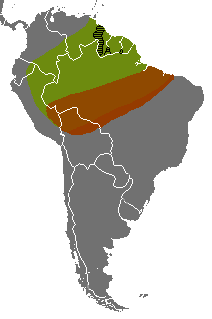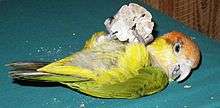Caique
| Caiques | |
|---|---|
3.jpg) | |
| Black-headed parrot, Pionites melanocephalus | |
| Scientific classification | |
| Kingdom: | Animalia |
| Phylum: | Chordata |
| Class: | Aves |
| Order: | Psittaciformes |
| Family: | Psittacidae |
| Tribe: | Arini |
| Genus: | Pionites Heine, 1890 |
| Species | |
 | |
| Ranges of black-headed parrot (green) and white-bellied parrot complex overlap | |
The caiques (/kaɪˈiːk/ or /kɑːˈiːk/[2]) are species of parrots in the genus Pionites. They are relatively small and stocky, with a short, square tail and very bright colors. Their typical weight is 150–170 grams. They can live up to 40 years. They are endemic in the Amazon Basin in South America, with the black-headed north of the Amazon River, and the white-bellied south. They are listed on Appendix 2 of CITES as a species of least concern. They generally prefer forested areas and subsist on fruit and seeds. Caiques are generally canopy dwellers, spending most of their time in the tops of trees, foraging and playing. Caique wing feathers produce a distinctive whirring sound in flight. They are highly vocal.
Taxonomy and systematics
Originally Pionites had two species, the black-headed parrot and white-bellied parrot. However, recent morphological work has indicated that the white-bellied parrot should be split into three species based on plumage and leg coloration.[1] In the past these parrots were often allied with the conures or other South American parakeets, recent mitochondrial and nuclear DNA work has found Pionites being the sister taxon to the Deroptyus (the genus that contains the red-fan parrot); the two genera occupy a basal position in the tribe Arini.[3]
| Pionites | |||
|---|---|---|---|
| Common name (binomial name) status |
Image | Description | Region and habitat |
| Green-thighed parrot (Pionites leucogaster) |
 |
About 23 cm (9.1 in) long. Mostly green and pink feet; apricot-orange cap; a medium, chunky parrot. | Amazon region of Brazil Lives in lowland humid tropical and seasonally flooded forest.[5] |
| Yellow-tailed parrot (Pionites xanthurus) |
About 23 cm (9.1 in) long. Similar to the black-legged parrot, but yellow tail and pink feet. | Amazon region of southern Brazil Lives in lowland humid tropical and seasonally flooded forest.[7] | |
| Black-legged parrot (Pionites xanthomerius) |
 |
About 23 cm (9.1 in) long. Similar to the green-thighed parrot, but yellow-thighed and blackish feet. | Parts in Bolivia, Peru and Brazil Prefers in seasonally flooded forest.[9] |
| Black-headed parrot (Pionites melanocephalus) |
|
About 23 cm (9.1 in) long. Mostly green, with yellow thighs with hints of orange; blackish feet; black cap with a black bill; a medium, chunky parrot.[11] | Parts in Colombia, Venezuela, Guiana, Peru, and Brazil Lives in lowland humid tropical and seasonally flooded forest.[12] |
Natural history
Behavior and ecology
These parrots are found in the edges of forests and secondary-growth forests.[13] They usually forage on at higher levels in the canopy, although can also be found lower at forest edges. At least two members of the flock acted as sentries during feeding time. Their diet consists of flowers, fruit, pulp, and seeds, although in captivity they are known to eat insects. Depending on the species and the location, they can breed from October to May at various times of the year. Caiques are high-nesting cavity birds and roost communally. The number of the flock is usually around 10 to 30 individuals.[14]
The species of the white-bellied parrot complex is found in humid forest and wooded habitats in the Amazon south of the Amazon River in Bolivia, Brazil, and Peru. It is generally fairly common throughout its range and is easily seen in a wide range of protected areas, such as the Manú National Park and Tambopata-Candamo in Peru, Cristalino State Park (near Alta Floresta), Xingu National Park and Amazônia National Park in Brazil, and Madidi National Park in Bolivia.
The black-headed parrot is found in forest (especially, but not exclusively, humid) and nearby wooded habitats in the Amazon north of the Amazon River and west of the Ucayali River in Brazil, northern Bolivia, Colombia, Ecuador, French Guiana, Guyana, Peru, Suriname, and Venezuela. It is generally fairly common and occurs in many protected areas throughout its range.
Aviculture

Caiques are growing in popularity in aviculture. The more commonly found species is the black-headed caique since it was introduced first in captivity, but the white-bellied caique's popularity is growing rapidly. Well-raised caiques bond well with humans and have a reputation as playful and energetic birds that enjoy playing with toys and lying on their backs, as shown in the photo on the right. These birds sometimes perform a behavior unusual for avian species in which they roll over on their backs in apparent play - sometimes called "wrestling".[15][16][17] They are not particularly good flyers, becoming tired and winded after only a short distance. They also tend to be clumsy and slow in the air compared to other birds. They often prefer to walk, jump, climb, or hop as a mode of transportation. They are excellent climbers, with very strong feet and legs.
Caiques also exhibit a unique behavior known as "surfing", where the bird will vigorously rub its face, wings and chest against any nearby soft item (e.g. carpets, towels, cushions, crumpled paper, curtains or human hair) while using its beak to pull itself along. During this, the bird will display jerky movements and may roll over several times. This behavior is thought to be a cleaning or bathing motion and occurs regardless of age or sex. In the wild, caiques use wet leaves for this behavior.
In captivity caiques are capable of breeding at under three years of age.[18] They typically lay a clutch of four eggs, with incubation taking between 24–27 days. Most pairs will however struggle to raise all four chicks, with often the last chick to hatch not surviving unless it is taken for hand-rearing or co-parenting. Chicks are fed by both parents and remain in the nest box for approximately 70–75 days. Parents can be very affectionate towards their offspring and after the chicks have fledged they will return to the nest box each night with their parents where the family will roost as a group.
References
- 1 2 3 del Hoyo, J., Collar, N. & Kirwan, G.M. (2014). Black-legged Parrot (Pionites xanthomerius). In: del Hoyo, J., Elliott, A., Sargatal, J., Christie, D.A. & de Juana, E. (eds.) (2014). Handbook of the Birds of the World Alive. Lynx Edicions, Barcelona. (retrieved from http://www.hbw.com/node/467506 on 24 October 2015)
- ↑ Jones, Daniel (2003) [1917], Peter Roach; James Hartmann; Jane Setter, eds., English Pronouncing Dictionary, Cambridge: Cambridge University Press, ISBN 3-12-539683-2
- ↑ Tavares, Erika Sendra, et al. "Phylogenetic relationships and historical biogeography of neotropical parrots (Psittaciformes: Psittacidae: Arini) inferred from mitochondrial and nuclear DNA sequences." Systematic Biology 55.3 (2006): 454-470.
- ↑ BirdLife International (2012). "Pionites leucogaster". IUCN Red List of Threatened Species. Version 2014.2. International Union for Conservation of Nature. Retrieved 26 November 2013.
- ↑ Collar, N., Kirwan, G.M. & Boesman, P. (2014). Green-thighed Parrot (Pionites leucogaster). In: del Hoyo, J., Elliott, A., Sargatal, J., Christie, D.A. & de Juana, E. (eds.) (2014). Handbook of the Birds of the World Alive. Lynx Edicions, Barcelona. (retrieved from http://www.hbw.com/node/54710 on 3 January 2015).
- ↑ BirdLife International 2014. Pionites xanthurus. The IUCN Red List of Threatened Species. Version 2014.3. <www.iucnredlist.org>. Downloaded on 3 January 2015.
- ↑ del Hoyo, J., Collar, N. & Kirwan, G.M. (2014). Yellow-tailed Parrot (Pionites xanthurus). In: del Hoyo, J., Elliott, A., Sargatal, J., Christie, D.A. & de Juana, E. (eds.) (2014). Handbook of the Birds of the World Alive. Lynx Edicions, Barcelona. (retrieved from http://www.hbw.com/node/467507 on 3 January 2015).
- ↑ BirdLife International (2015) Species factsheet: Pionites xanthomerius. Downloaded from "Archived copy". Archived from the original on 2007-07-10. Retrieved 2012-12-10. on 03/01/2015.
- ↑ BirdLife International 2014. Pionites xanthomerius. The IUCN Red List of Threatened Species. Version 2014.3. <www.iucnredlist.org>. Downloaded on 3 January 2015.
- ↑ BirdLife International (2012). "Pionites melanocephalus". IUCN Red List of Threatened Species. Version 2013.2. International Union for Conservation of Nature. Retrieved 26 November 2013.
- ↑ Collar, N. & Boesman, P. (2013). Black-headed Parrot (Pionites melanocephalus). In: del Hoyo, J., Elliott, A., Sargatal, J., Christie, D.A. & de Juana, E. (eds.) (2013). Handbook of the Birds of the World Alive. Lynx Edicions, Barcelona. (retrieved from http://www.hbw.com/node/54709 on 3 January 2015).
- ↑ BirdLife International (2015) Species factsheet: Pionites melanocephalus. Downloaded from "Archived copy". Archived from the original on 2007-07-10. Retrieved 2012-12-10.
- ↑ Forshaw, J.M. 1973. Parrots of the World. Lansdowne Press, Melbourne, Australia . pp. 481-483.
- ↑ Juniper, T., and M. Parr. 1998. Parrots. A Guide to Parrots of the World. Yale University Press, New Haven, CN pp. 503-505.
- ↑ https://www.youtube.com/watch?v=Cbtk0CqIkhM
- ↑ https://www.youtube.com/watch?v=RDMOyd8E-Jo
- ↑ https://www.youtube.com/watch?v=y6UrdzGc5-4
- ↑ http://clownparrots.com/index.php/menu-breeding-caiques
External links
- The Caique Site, with bibliography and scientific articles
- http://www.clownparrots.com A website about Caiques in captivity and the wild, with maps, pictures and videos
- Popular description - Companion Parrot Online Website